Data Warehouse Management System Report: Design and Implementation
VerifiedAdded on 2022/12/29
|8
|1043
|58
Report
AI Summary
This report presents a data warehouse management system designed for an auto parts business. It begins with an introduction to data warehousing and the business context of Jack and Daniel's auto parts business, highlighting the need for an upgraded system. The report then outlines the functional and non-functional requirements, including features such as order management, inventory tracking, and invoice generation. The design phase includes a use case diagram, a domain model class diagram, and an event partition system model to visually represent the system's components and processes. The use cases cover various aspects of warehouse operations, from order loading and processing to shipment tracking and report generation. The diagrams provide a detailed view of the system's architecture and the relationships between different elements. The report concludes by emphasizing the benefits of the proposed system in enhancing business performance and meeting specific requirements. The system ensures efficient data management and improved operational capabilities for the auto parts business.
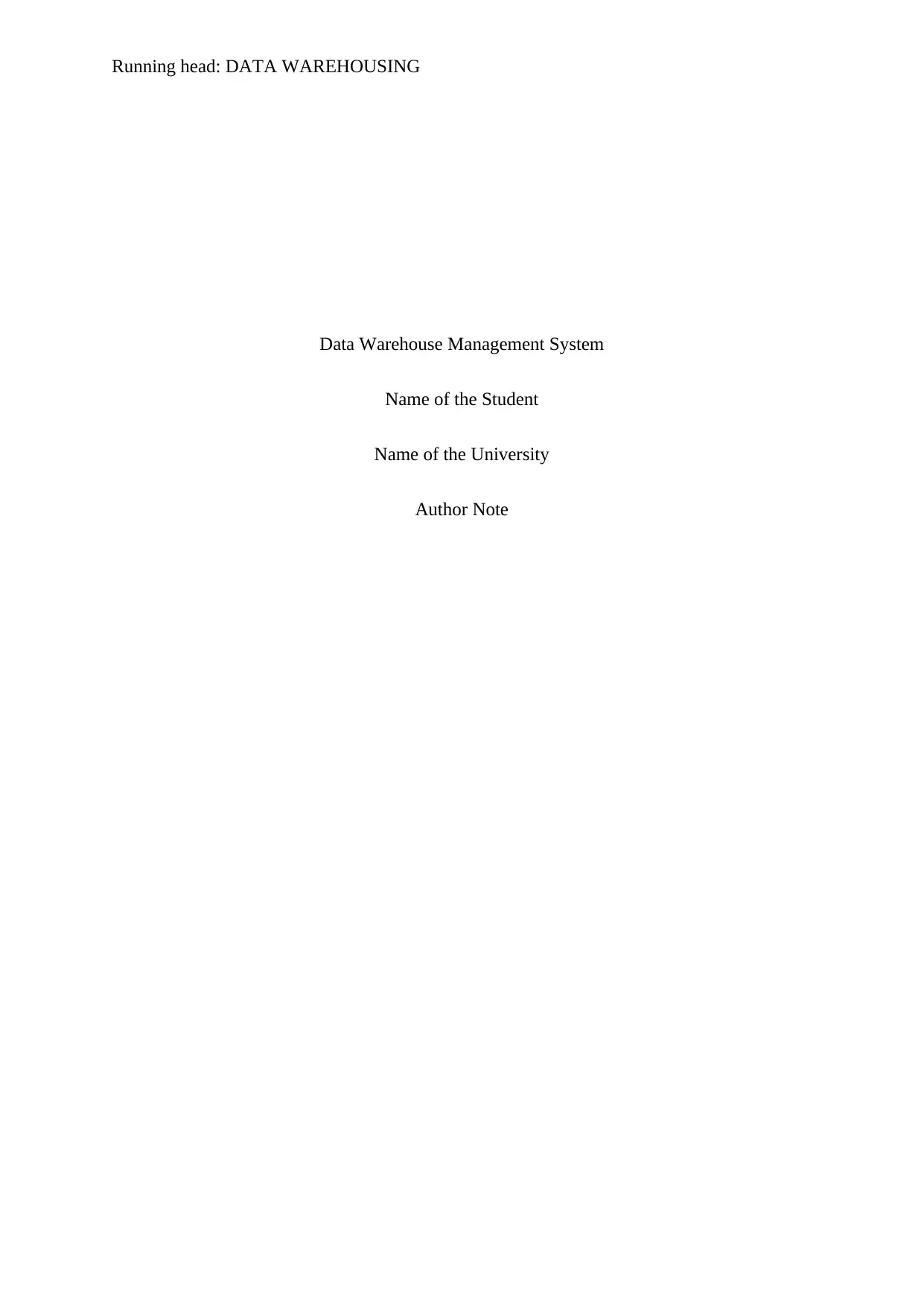
Running head: DATA WAREHOUSING
Data Warehouse Management System
Name of the Student
Name of the University
Author Note
Data Warehouse Management System
Name of the Student
Name of the University
Author Note
Paraphrase This Document
Need a fresh take? Get an instant paraphrase of this document with our AI Paraphraser
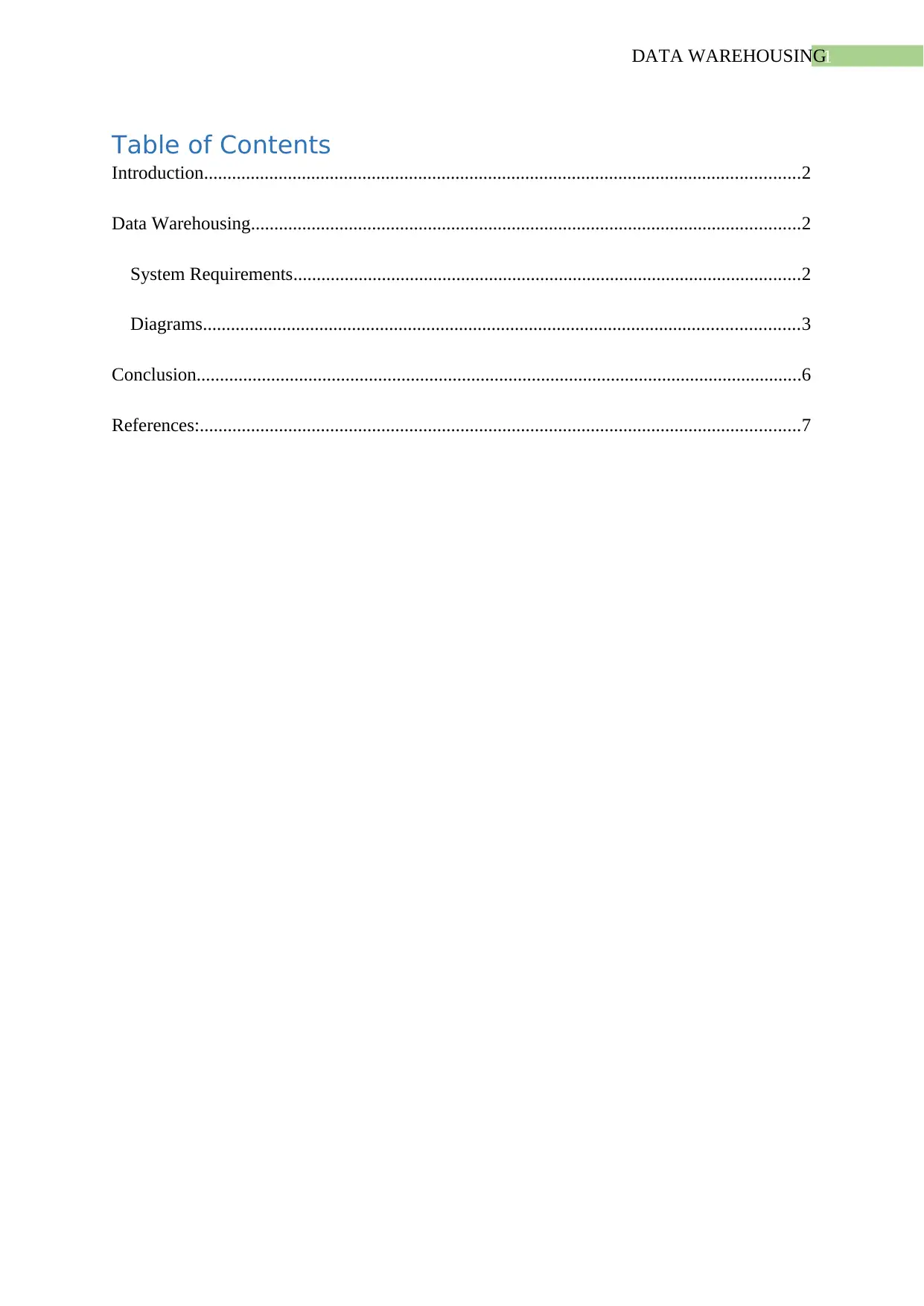
1DATA WAREHOUSING
Table of Contents
Introduction................................................................................................................................2
Data Warehousing......................................................................................................................2
System Requirements.............................................................................................................2
Diagrams................................................................................................................................3
Conclusion..................................................................................................................................6
References:.................................................................................................................................7
Table of Contents
Introduction................................................................................................................................2
Data Warehousing......................................................................................................................2
System Requirements.............................................................................................................2
Diagrams................................................................................................................................3
Conclusion..................................................................................................................................6
References:.................................................................................................................................7
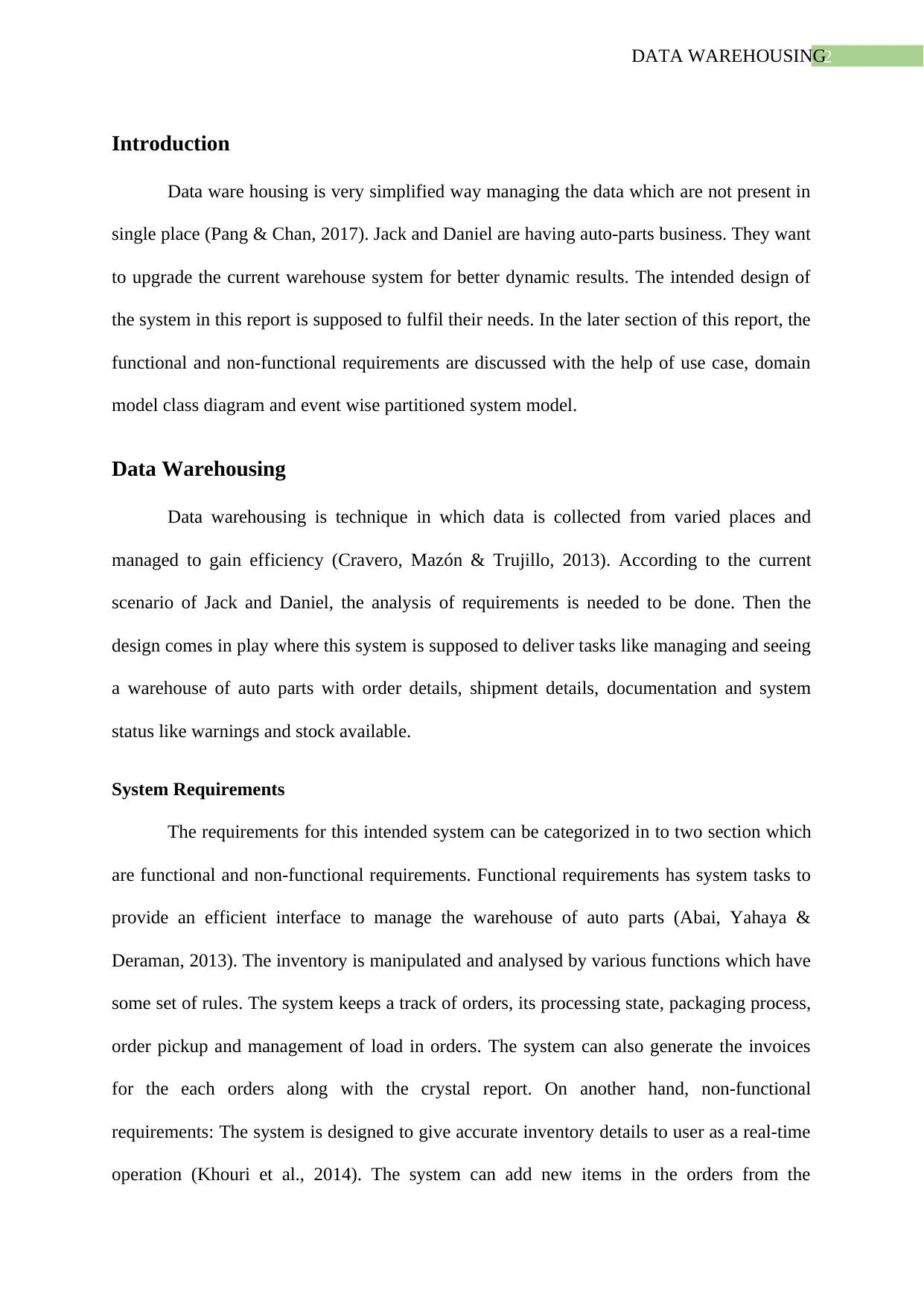
2DATA WAREHOUSING
Introduction
Data ware housing is very simplified way managing the data which are not present in
single place (Pang & Chan, 2017). Jack and Daniel are having auto-parts business. They want
to upgrade the current warehouse system for better dynamic results. The intended design of
the system in this report is supposed to fulfil their needs. In the later section of this report, the
functional and non-functional requirements are discussed with the help of use case, domain
model class diagram and event wise partitioned system model.
Data Warehousing
Data warehousing is technique in which data is collected from varied places and
managed to gain efficiency (Cravero, Mazón & Trujillo, 2013). According to the current
scenario of Jack and Daniel, the analysis of requirements is needed to be done. Then the
design comes in play where this system is supposed to deliver tasks like managing and seeing
a warehouse of auto parts with order details, shipment details, documentation and system
status like warnings and stock available.
System Requirements
The requirements for this intended system can be categorized in to two section which
are functional and non-functional requirements. Functional requirements has system tasks to
provide an efficient interface to manage the warehouse of auto parts (Abai, Yahaya &
Deraman, 2013). The inventory is manipulated and analysed by various functions which have
some set of rules. The system keeps a track of orders, its processing state, packaging process,
order pickup and management of load in orders. The system can also generate the invoices
for the each orders along with the crystal report. On another hand, non-functional
requirements: The system is designed to give accurate inventory details to user as a real-time
operation (Khouri et al., 2014). The system can add new items in the orders from the
Introduction
Data ware housing is very simplified way managing the data which are not present in
single place (Pang & Chan, 2017). Jack and Daniel are having auto-parts business. They want
to upgrade the current warehouse system for better dynamic results. The intended design of
the system in this report is supposed to fulfil their needs. In the later section of this report, the
functional and non-functional requirements are discussed with the help of use case, domain
model class diagram and event wise partitioned system model.
Data Warehousing
Data warehousing is technique in which data is collected from varied places and
managed to gain efficiency (Cravero, Mazón & Trujillo, 2013). According to the current
scenario of Jack and Daniel, the analysis of requirements is needed to be done. Then the
design comes in play where this system is supposed to deliver tasks like managing and seeing
a warehouse of auto parts with order details, shipment details, documentation and system
status like warnings and stock available.
System Requirements
The requirements for this intended system can be categorized in to two section which
are functional and non-functional requirements. Functional requirements has system tasks to
provide an efficient interface to manage the warehouse of auto parts (Abai, Yahaya &
Deraman, 2013). The inventory is manipulated and analysed by various functions which have
some set of rules. The system keeps a track of orders, its processing state, packaging process,
order pickup and management of load in orders. The system can also generate the invoices
for the each orders along with the crystal report. On another hand, non-functional
requirements: The system is designed to give accurate inventory details to user as a real-time
operation (Khouri et al., 2014). The system can add new items in the orders from the
⊘ This is a preview!⊘
Do you want full access?
Subscribe today to unlock all pages.

Trusted by 1+ million students worldwide
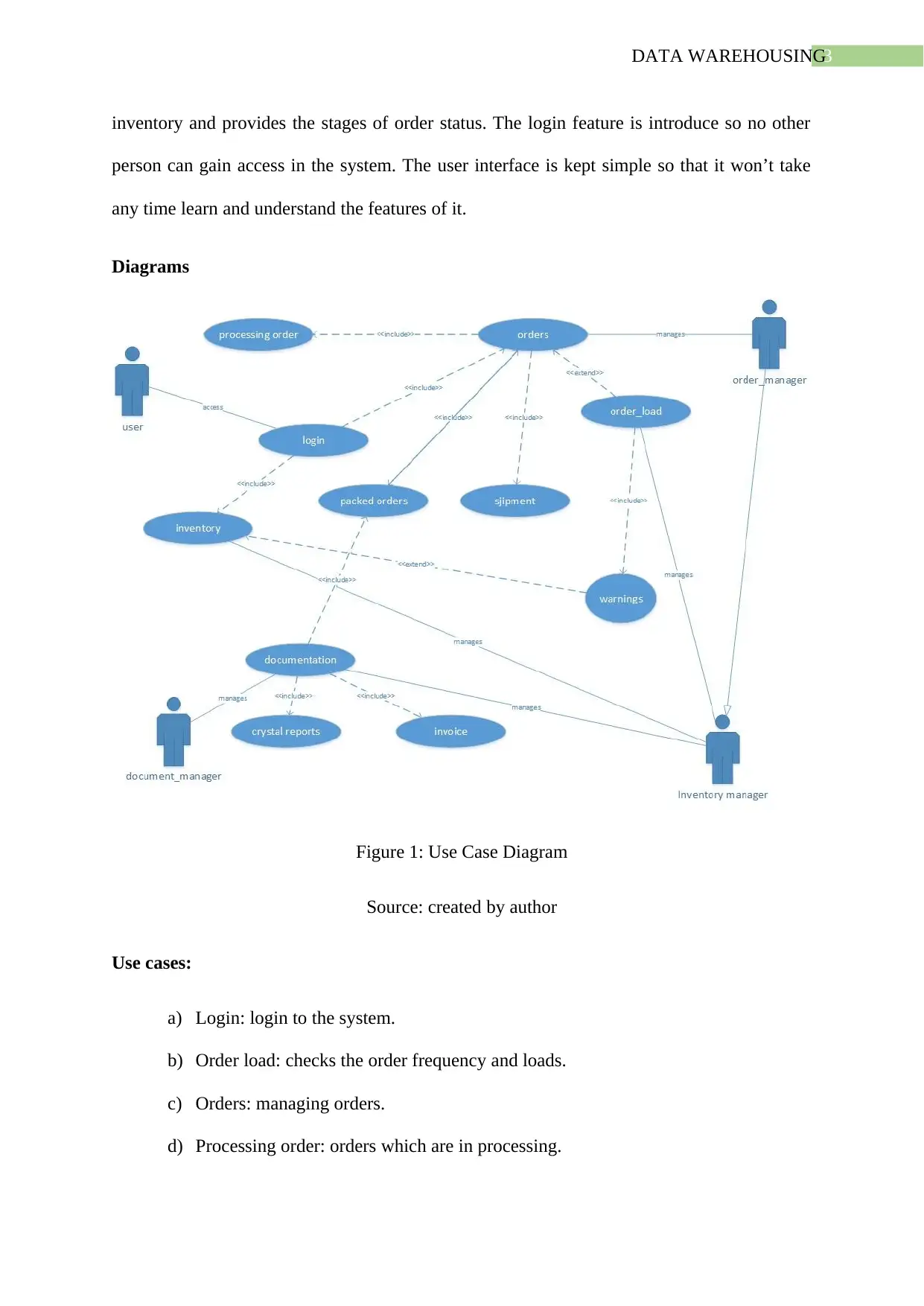
3DATA WAREHOUSING
inventory and provides the stages of order status. The login feature is introduce so no other
person can gain access in the system. The user interface is kept simple so that it won’t take
any time learn and understand the features of it.
Diagrams
Figure 1: Use Case Diagram
Source: created by author
Use cases:
a) Login: login to the system.
b) Order load: checks the order frequency and loads.
c) Orders: managing orders.
d) Processing order: orders which are in processing.
inventory and provides the stages of order status. The login feature is introduce so no other
person can gain access in the system. The user interface is kept simple so that it won’t take
any time learn and understand the features of it.
Diagrams
Figure 1: Use Case Diagram
Source: created by author
Use cases:
a) Login: login to the system.
b) Order load: checks the order frequency and loads.
c) Orders: managing orders.
d) Processing order: orders which are in processing.
Paraphrase This Document
Need a fresh take? Get an instant paraphrase of this document with our AI Paraphraser
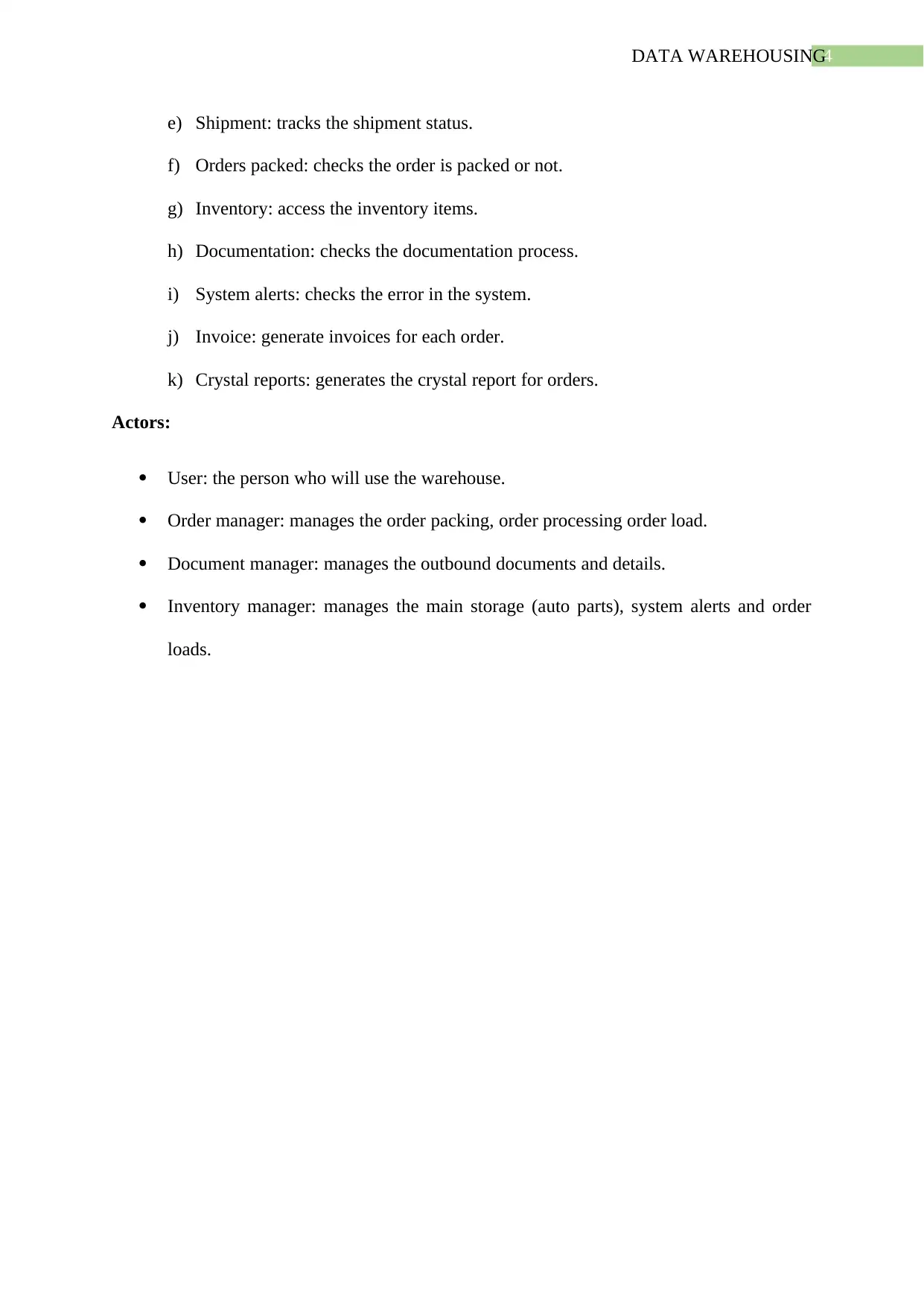
4DATA WAREHOUSING
e) Shipment: tracks the shipment status.
f) Orders packed: checks the order is packed or not.
g) Inventory: access the inventory items.
h) Documentation: checks the documentation process.
i) System alerts: checks the error in the system.
j) Invoice: generate invoices for each order.
k) Crystal reports: generates the crystal report for orders.
Actors:
User: the person who will use the warehouse.
Order manager: manages the order packing, order processing order load.
Document manager: manages the outbound documents and details.
Inventory manager: manages the main storage (auto parts), system alerts and order
loads.
e) Shipment: tracks the shipment status.
f) Orders packed: checks the order is packed or not.
g) Inventory: access the inventory items.
h) Documentation: checks the documentation process.
i) System alerts: checks the error in the system.
j) Invoice: generate invoices for each order.
k) Crystal reports: generates the crystal report for orders.
Actors:
User: the person who will use the warehouse.
Order manager: manages the order packing, order processing order load.
Document manager: manages the outbound documents and details.
Inventory manager: manages the main storage (auto parts), system alerts and order
loads.
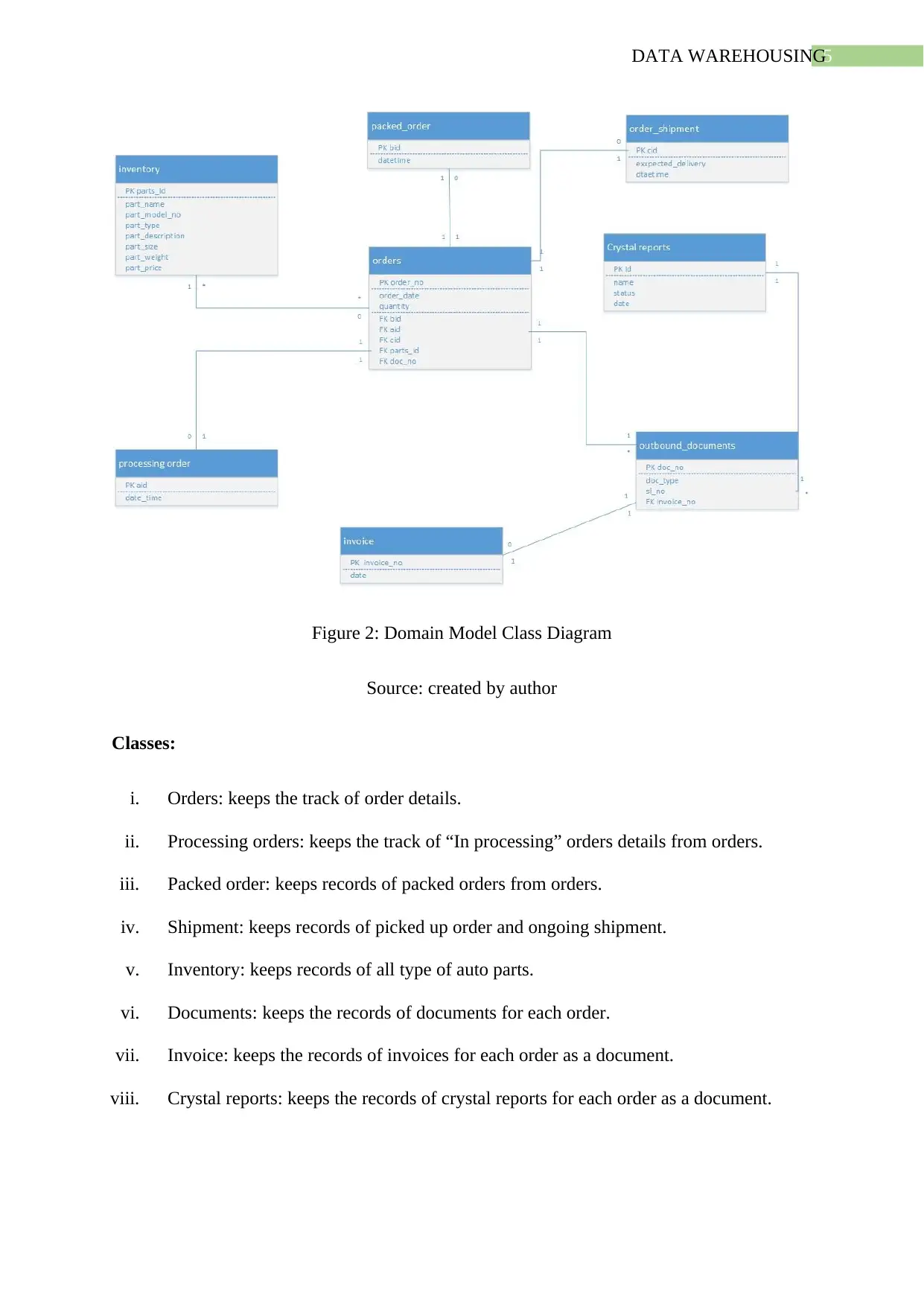
5DATA WAREHOUSING
Figure 2: Domain Model Class Diagram
Source: created by author
Classes:
i. Orders: keeps the track of order details.
ii. Processing orders: keeps the track of “In processing” orders details from orders.
iii. Packed order: keeps records of packed orders from orders.
iv. Shipment: keeps records of picked up order and ongoing shipment.
v. Inventory: keeps records of all type of auto parts.
vi. Documents: keeps the records of documents for each order.
vii. Invoice: keeps the records of invoices for each order as a document.
viii. Crystal reports: keeps the records of crystal reports for each order as a document.
Figure 2: Domain Model Class Diagram
Source: created by author
Classes:
i. Orders: keeps the track of order details.
ii. Processing orders: keeps the track of “In processing” orders details from orders.
iii. Packed order: keeps records of packed orders from orders.
iv. Shipment: keeps records of picked up order and ongoing shipment.
v. Inventory: keeps records of all type of auto parts.
vi. Documents: keeps the records of documents for each order.
vii. Invoice: keeps the records of invoices for each order as a document.
viii. Crystal reports: keeps the records of crystal reports for each order as a document.
⊘ This is a preview!⊘
Do you want full access?
Subscribe today to unlock all pages.

Trusted by 1+ million students worldwide
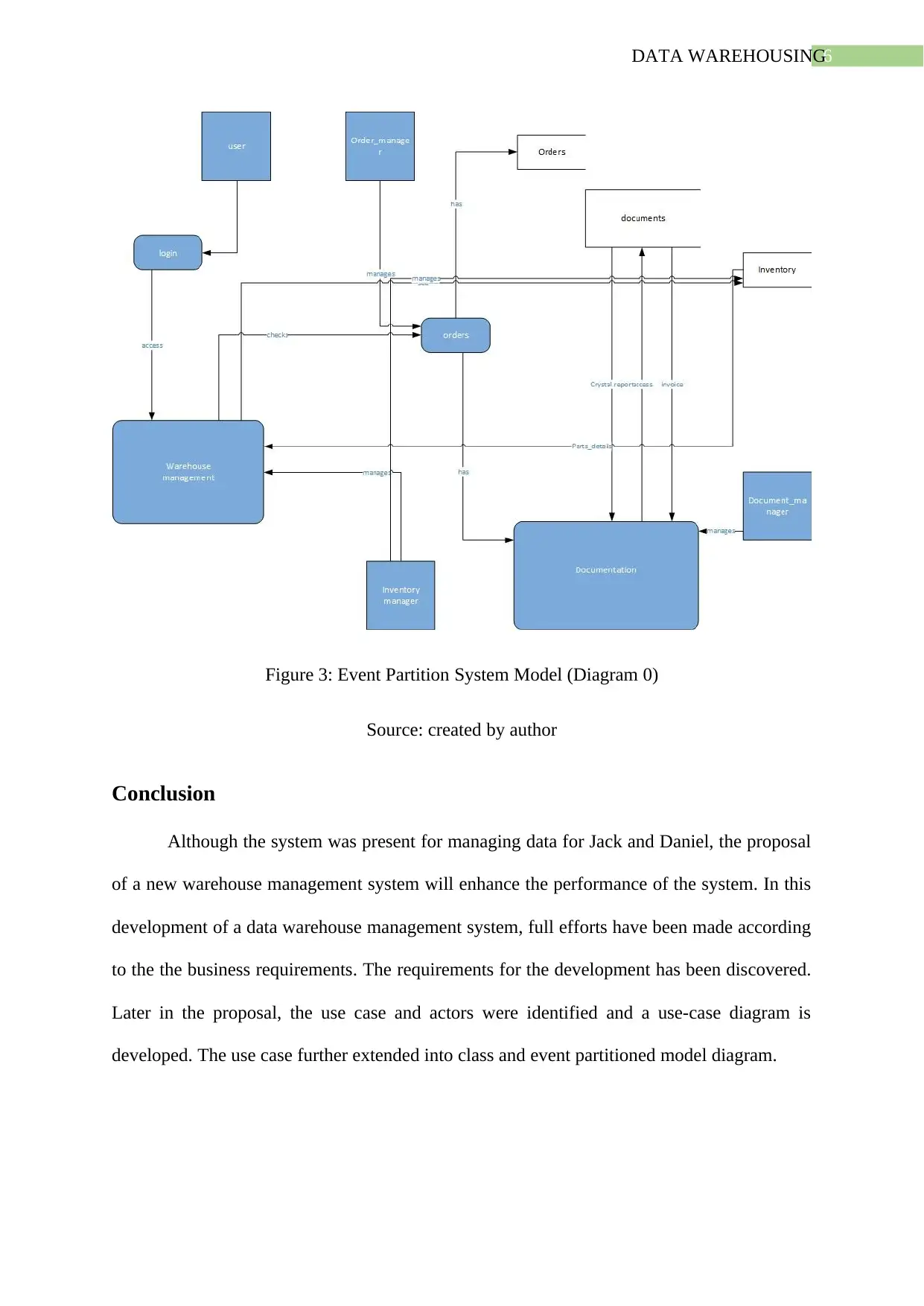
6DATA WAREHOUSING
Figure 3: Event Partition System Model (Diagram 0)
Source: created by author
Conclusion
Although the system was present for managing data for Jack and Daniel, the proposal
of a new warehouse management system will enhance the performance of the system. In this
development of a data warehouse management system, full efforts have been made according
to the the business requirements. The requirements for the development has been discovered.
Later in the proposal, the use case and actors were identified and a use-case diagram is
developed. The use case further extended into class and event partitioned model diagram.
Figure 3: Event Partition System Model (Diagram 0)
Source: created by author
Conclusion
Although the system was present for managing data for Jack and Daniel, the proposal
of a new warehouse management system will enhance the performance of the system. In this
development of a data warehouse management system, full efforts have been made according
to the the business requirements. The requirements for the development has been discovered.
Later in the proposal, the use case and actors were identified and a use-case diagram is
developed. The use case further extended into class and event partitioned model diagram.
Paraphrase This Document
Need a fresh take? Get an instant paraphrase of this document with our AI Paraphraser
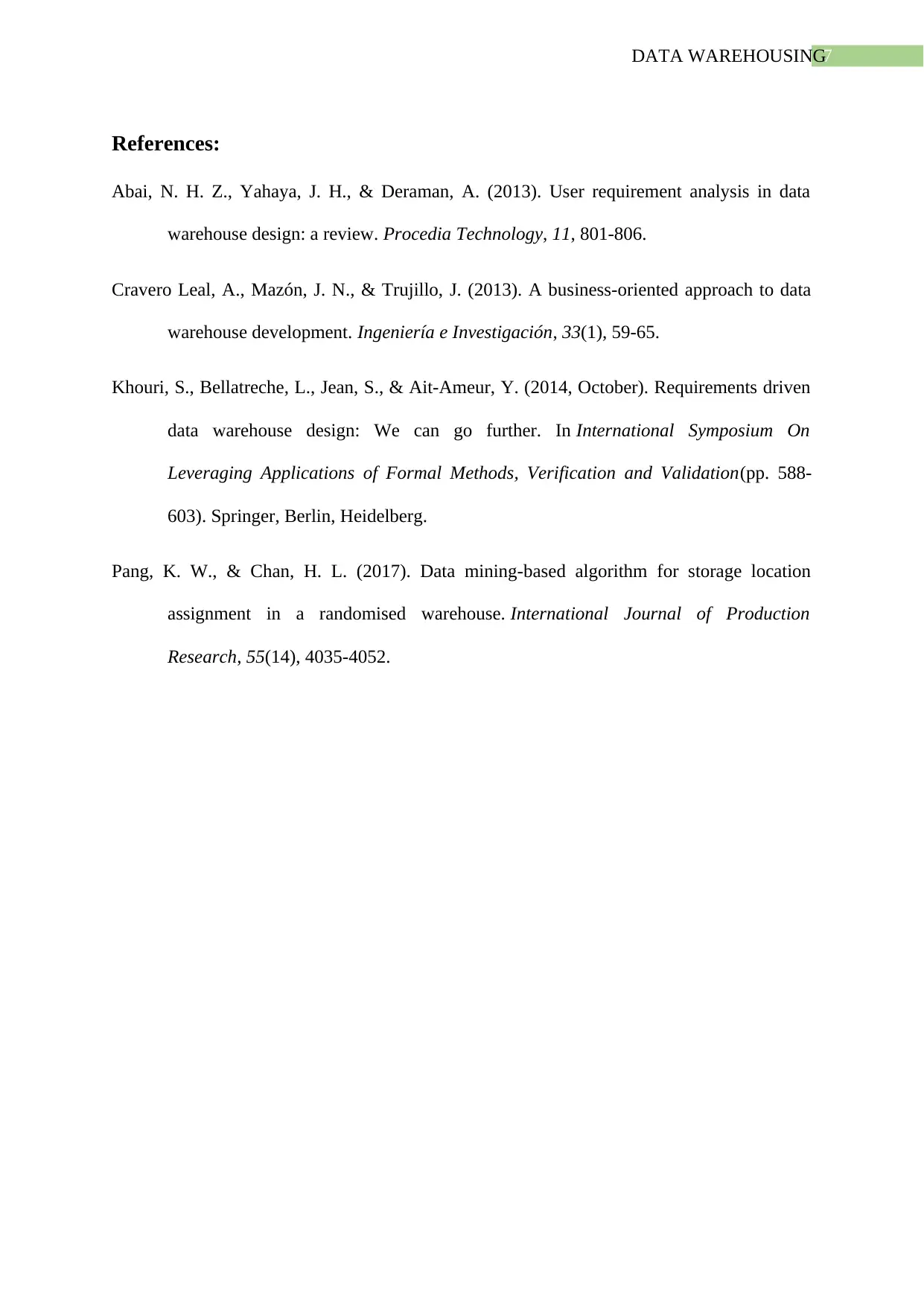
7DATA WAREHOUSING
References:
Abai, N. H. Z., Yahaya, J. H., & Deraman, A. (2013). User requirement analysis in data
warehouse design: a review. Procedia Technology, 11, 801-806.
Cravero Leal, A., Mazón, J. N., & Trujillo, J. (2013). A business-oriented approach to data
warehouse development. Ingeniería e Investigación, 33(1), 59-65.
Khouri, S., Bellatreche, L., Jean, S., & Ait-Ameur, Y. (2014, October). Requirements driven
data warehouse design: We can go further. In International Symposium On
Leveraging Applications of Formal Methods, Verification and Validation(pp. 588-
603). Springer, Berlin, Heidelberg.
Pang, K. W., & Chan, H. L. (2017). Data mining-based algorithm for storage location
assignment in a randomised warehouse. International Journal of Production
Research, 55(14), 4035-4052.
References:
Abai, N. H. Z., Yahaya, J. H., & Deraman, A. (2013). User requirement analysis in data
warehouse design: a review. Procedia Technology, 11, 801-806.
Cravero Leal, A., Mazón, J. N., & Trujillo, J. (2013). A business-oriented approach to data
warehouse development. Ingeniería e Investigación, 33(1), 59-65.
Khouri, S., Bellatreche, L., Jean, S., & Ait-Ameur, Y. (2014, October). Requirements driven
data warehouse design: We can go further. In International Symposium On
Leveraging Applications of Formal Methods, Verification and Validation(pp. 588-
603). Springer, Berlin, Heidelberg.
Pang, K. W., & Chan, H. L. (2017). Data mining-based algorithm for storage location
assignment in a randomised warehouse. International Journal of Production
Research, 55(14), 4035-4052.
1 out of 8
Related Documents
Your All-in-One AI-Powered Toolkit for Academic Success.
+13062052269
info@desklib.com
Available 24*7 on WhatsApp / Email
![[object Object]](/_next/static/media/star-bottom.7253800d.svg)
Unlock your academic potential
© 2024 | Zucol Services PVT LTD | All rights reserved.





